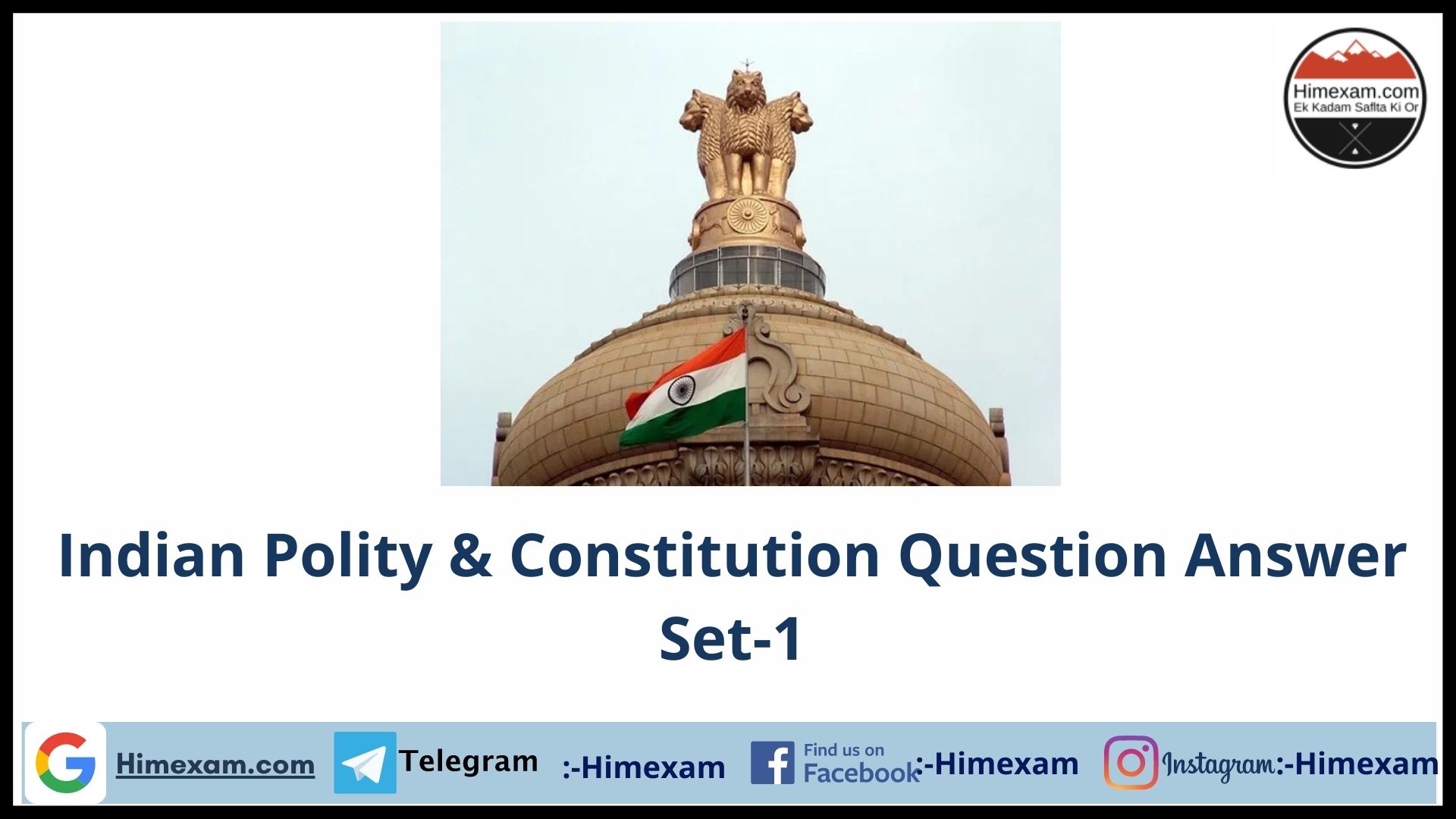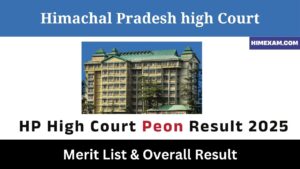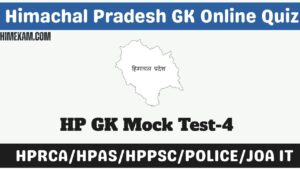Table of Contents
ToggleIndian Polity & Constitution Question Answer Set-1
||Indian Polity & Constitution Question Answer Set-1||Indian Polity & Constitution MCQ Set-1||
1. A federal structure for India was first put forward by the :
(A) Act of 1909
(B) Act of 1919
(C) Act of 1935
(D) Act of 1947
Explanation:-The Government of India Act 1935, the voluminous and final constitutional effort at governing British India, articulated three major goals: establishing a loose federal structure, achieving provincial autonomy, and safeguarding minority interests through separate electorates. The federal provisions, intended to unite princely states and British India at the centre, were not implemented because of ambiguities in safeguarding the existing privileges of princes. In February 1937, however, provincial autonomy became a reality when elections were held
2. Which of the following exercised the most profound influence in framing the Indian Constitution?
(A) British Constitution
(B) US Constitution
(C) Irish Constitution
(D) The Government of India Act, 1935
Explanation:-The most profound influence was exercised by the Government of India Act of 1935. Such features as the federal scheme, office of governor, power of federal judiciary, emergency powers etc were drawn from this Act. The British practice influenced the lawmaking procedures, rule of law, system of single citizenship, besides, of course, the model of a parliamentary government. The US Constitution inspired details on the independence of judiciary, judicial review, fundamental rights, and the removal of Supreme Court and High Court judges. The Irish Constitution was the source of the Directive Principles, method of Presidential elections, and the nomination of members of Rajya Sabha by the President.
3. How does the Constitution of India describe India as?
(A) A federation of States and Union Territories
(B) A Union of States
(C) Bharatvarsh
(D) A federated nation
Explanation:-With its adoption, the Union of India officially became the modern and contemporary Republic of India and it replaced the Government of India Act 1935 as the country’s fundamental governing document. The Constitution declares India to be a sovereign, socialist, secular, democratic republic, assuring its citizens of justice, equality, and liberty, and endeavours to promote fraternity among them
4. The system of judicial review originated in
(A) India
(B) Gemany
(C) Russia
(D) U.S.A.
Explanation:-Judicial review is the doctrine under which legislative and executive actions are subject to review (and possible invalidation) by the judiciary. It is an example of the separation of powers in a modern governmental system (where the judiciary is one of three branches of government). Is is one of the main characteristics of government in the Republic of the United States. In the United States, federal and state courts (at all levels, both appellate and trial) are able to review and declare the “constitutionality”, or agreement with the Constitution (or lack there of) of legislation that is relevant to any case properly within their jurisdiction. In American legal language, “judicial review” refers primarily to the adjudication of constitutionality of statutes, especially by the Supreme Court of the United States.
5. Preventive detention means–
(A) detention for interrogation
(B) detention after interrogation
(C) detention without interrogation
(D) detention for cognisable offence.
Explanation:-Preventive detention is an imprisonment that is putatively justified for non-punitive purposes. In contrast to this, under preventive detention the government can imprison a person for some time without a criminal charge. It means that if the government feels that a person being at liberty can be a threat to the law and order or the unity and integrity of the nation, it can detain or arrest that person to prevent him from doing this possible harm
6. What was the basis for constituting the Constituent Assembly of India ?
(A) The Resolution of the Indian National Congress
(B) The Cabinet Mission Plan, 1946
(C) The Indian Independence Act, 1947
(D) The resolutions of the Provincial/State Legislatures of the Dominion of India
Explanation:-The Constituent Assembly of India was elected to write the Constitution of India. The Constituent Assembly was set up while India was still under British rule, following negotiations between Indian leaders and members of the 1946 Cabinet Mission to India from the United Kingdom. The Assembly members were elected to it indirectly by the members of the individual provincial legislative assemblies, and initially included representatives for those provinces which came to form part of Pakistan, some of which are now within Bangladesh
7. From the Constitution of which country the provision of Federation was borrowed while framing the Constitution of India ?
(A) USA
(B) UK
(C) Canada
(D) Switzerland
Explanation:-Though the basic features of Indian Constitution are based on the Government of India Act, 1935, it has many features which were borrowed from many foreign constitutions. It was from the Canadian Constitution that India borrowed a quasi-federal form of government (a federal system with a strong central government) and the idea of Residual Powers.
8. Who among the following was not a member of the Consti-tuent Assembly established in July 1946 ?
(A) Dr. Rajendra Prasad
(B) K M Munshi
(C) Mahatma Gandhi
(D) Abul Kalam Azad
Explanation:-The Constituent Assembly of India was elected to write the Constitution of India. Some of its prominent members were Pandit Jawaharlal Nehru, Maulana Abul Kalam Azad, Sardar Vallabhbhai Patel, Acharya J.B. Kriplani, Dr. Rajendra Prasad, Smt. Sarojini Naidu, Shri Hare-Krushna Mahatab, Pandit Govind Ballabh Pant, Dr. B.R. Ambedkar, Shri Sarat Chandra Bose, Shri C. Rajagopalachari and Shri M. Asaf Ali
9. Who was the Chairman of the Drafting Committee of the Constitution ?
(A) J. B. Kripalani
(B) Rajendra Prasad
(C) J. L. Nehru
(D) B. R. Ambedkar
Explanation:-On 29 August, 1947, the Drafting Committee was appointed, with Dr B. R. Ambedkar as the Chairman along with six other members assisted by a constitutional advisor. These members were Kanaiyalal Maneklal Munshi (K M Munshi, Ex- Home Minister, Bombay), Alladi Krishnaswamy Iyer (ExAdvocate General, Madras State), N Gopalaswami Ayengar (Ex-Prime Minister, J&K and later member of Nehru Cabinet), B L Mitter (Ex-Advocate General, India), Md. Saadullah (Ex- Chief Minister of Assam, Muslim League member) and D P Khaitan (Scion of Khaitan Business family and a renowned lawyer). The constitutional advisor was Sir Benegal Narsing Rau (who became First Indian Judge in International Court of Justice, 1950–54)
10. India is a republic because—
(A) it is democratic country
(B) It is a parliamentary democracy
(C) the head of the state is elected for a definite period
(D) All of these
Explanation:-India is a republic because India elects its supreme head. It is called a republic because of the applicable definition of a republic: a form of government in which representatives are entitled to act on behalf of the people whom they represent.
||Indian Polity & Constitution Question Answer Set-1||Indian Polity & Constitution MCQ Set-1||
Join Our Telegram Group :- Himexam









